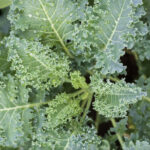 Do you remember when restaurant entrees came with a little garnish on the plate?
Do you remember when restaurant entrees came with a little garnish on the plate?
It might have been a sprig of parsley or watercress or perhaps a wedge of orange. And then there was my “favorite”: a little bed of curly kale with a red-spiced apple slice on it. For the majority of us, I suspect this little “treat” remained on the plate. Except for my mother. She ate the raw kale, the parsley sprigs and everything else that was dark green on her plate. She always told me how good kale was for me. She was ahead of her time.
Now, kale seems to be everywhere, and I keep wondering how that happened. And is there an Italian link?
I set out to do a little research. Kale is grown in Italy, particularly in Tuscany. Cavolo nero, known as black kale, is said to be more delicate than American varieties and can be found growing in many Italian backyard gardens. The kale plant is made sweeter when touched by frost, making it an excellent vegetable choice now that the growing season has ended.
I also learned that there are numerous Italian kale recipes out there (who knew?): slaw made with uncooked shredded kale, kale Caesar salad, kale stewed with white beans, kale pie with ricotta cheese, and all kinds of cheesy casseroles that mix kale with potatoes, breadcrumbs or squash. And although there are many variations, the classic Tuscan soup, ribollita, almost always includes cavolo nero. And kale chips are the new darlings of the “Paleo Diet” crowd.
Two of the produce vendors at my farmer’s market have been selling kale, so I thought I’d give it a try. I noted that one variety is very dark green, its leaves tinged with purple, while the other has curly, medium-green leaves much like Swiss chard. Neither was likely cavalo nero. Nevertheless, I wanted a way to incorporate this nutritious, but perhaps intimidating, vegetable into my cooking routine in a way that everyone would like.
Kale “smoothies” were out, but what about pasta? My family loves a pasta dish I often make for winter Sunday dinners. It is a La Cucina Italiana magazine recipe called penne con salsiccia e zafferano or penne with sausage and saffron. I decided to take several large kale leaves, cut out the center rib and chop the leaves very fine. I had about two cups of chopped kale, which I added to the onion-and-sausage mixture as it was sautéing and before adding the cream and saffron. The result was delicious and quite acceptable to my skeptical family, which is more accustomed to me sneaking spinach or arugula into my pasta dishes. It also added color to a rather bland-looking dish.
I thought my pasta with kale recipe was a great success. I may be a little more adventurous going forward with this new star of the winter greens family—perhaps a hearty soup or a kale and bean stew for a cold winter night. My mother would be proud. I hope you give it a try, too.
Penne with Sausage, Saffron and Kale
Ingredients
Fine sea salt
1/8 teaspoon crumbled saffron threads
2 tablespoons extra virgin olive oil
1 cup thinly sliced onion
1 tablespoon chopped fresh thyme leaves
¾ pound Italian sweet sausage, casings removed
1 cup heavy cream
1 pound penne pasta, cooked al dente
2 cups finely chopped fresh kale leaves, center ribs removed
- Dissolve the saffron threads into a tablespoon of warm water and set it aside.
- In a large, non-stick skillet, heat the olive oil over medium heat.
- Add the sliced onion and chopped thyme leaves and cook, stirring frequently, until the onion is softened.
- Add the sausage and cook, breaking up the sausage into small bits using a wooden spoon. Stir until it is no longer pink, about 6 to 10 minutes.
- Add the finely chopped kale leaves and sauté the mixture a few minutes more until the kale is wilted.
- Add the cream, the saffron mixture and a pinch of sea salt.
- Simmer for a few minutes, then remove from the heat and cover the pan to keep warm.
When the penne is cooked, transfer it to a large bowl and add the cream, kale and sausage mixture, tossing to combine. Salt to taste, adding a little at a time.
The recipe doesn’t call for it, but I added a generous amount of grated Parmesan cheese to the bowl and tossed the mixture again to melt the cheese and coat the pasta.
Note: Saffron is a spice made from a type of crocus flower and is sold in little envelopes in the spice section of the grocery store or at a specialty shop selling herbs and spices. It adds a bright yellow color to many dishes, especially chicken soup and has a very subtle taste. It is expensive, but very little is needed.





